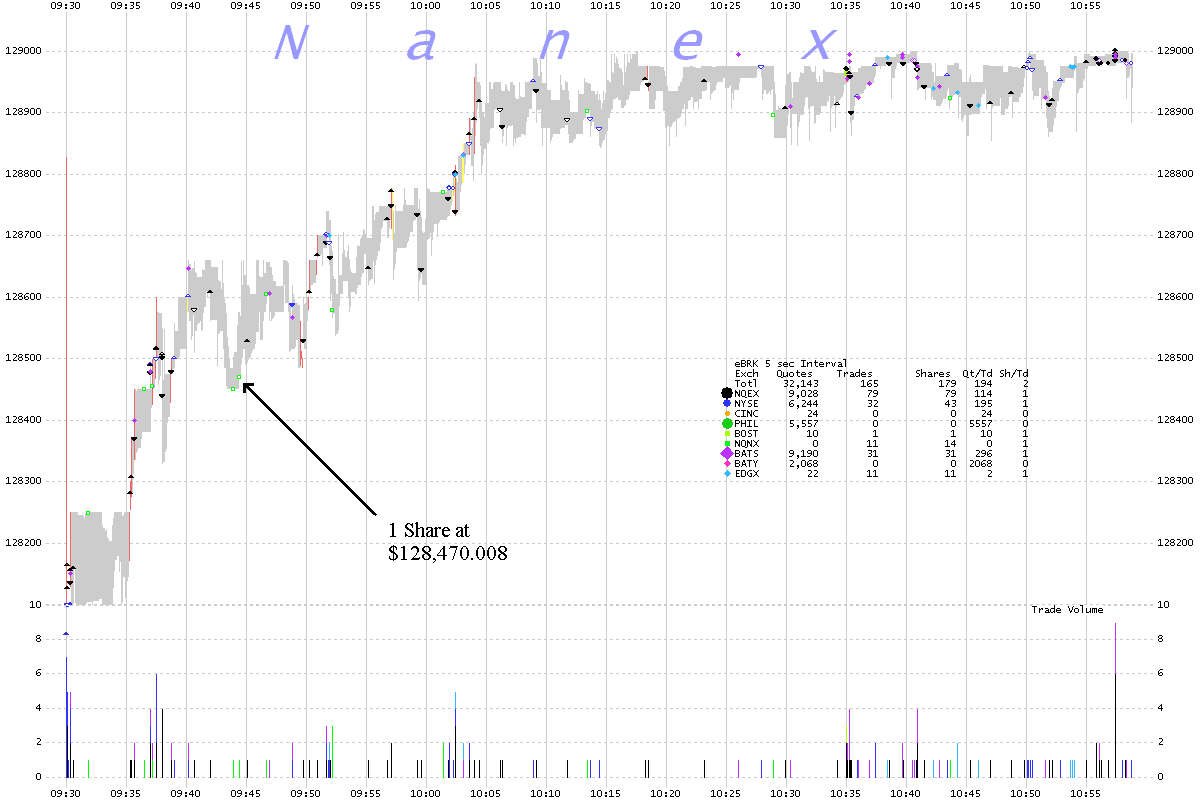
Nanex ~ 06-Sep-2012 ~ Berkshire Hathaway (again)Imagine buying a house. You do all the leg work: inspections, market analysis, etc. and arrive at a fair price which you then submit, in writing, to the seller. Suddenly, one second before closing, another buyer with special privileges shows up and offers the seller a penny more than you, and wins the property. The seller has no choice in the matter, they have to sell to the highest bidder. Think that is outrageous? It gets worse. Imagine this special buyer also has a month to try and flip the property onto someone else for a higher price. If they can't find anyone, they'll simply turn around and dump it on you, at the price you already agreed to. Even if a hurricane sweeps the house out to sea. That pretty much describes how market internalizers (wholesalers like Citadel) work.Once again the symbol BRK.A (Berkshire Hathaway, Class A) has come up on one of our market monitors that scan for unusual trading events. Last time BRK.A appeared, we wrote about how it crashed, losing 90% of its value in the blink of an eye (180 milliseconds). Just last month we documented the enormous quote/trade ratio in BRK.A, and last year posted about suspicious quote activity. This is a stock that often has fewer than 500 trades per day and averages just over 1 share per trade. Also, BRK.A is the highest priced stock on the NYSE: about $129,000; when it isn't flash crashing. Which is why we were shocked to see that Berkshire Hathaway, class A, has sub-penny trades! If you aren't familiar with sub-penny trading, you may want to read about it. Basically, someone cut in line, stepping in front of another investor who already placed an order to buy 1 share of BRK.A for $128,470.00. That investor's order was the highest bid at the time, and it set the National Best Bid for all markets trading BRK.A. But another trader, with special privileges, was able to place an order priced a mere 8/10ths of a cent higher and buy (steal) that share for $128,470.0080: a price improvement of 0.00000625%. This privileged trader could always dump the share on the investor for a small loss (8/10ths of a cent) if things turned around. All those without this special privilege must submit prices in even whole cent increments, and quotes can only appear in prices divisible by whole cents which is why this (line-jumping, pig-stealing, cattle-rustling) trader's order was invisible. In layman's terms: We'd also like to point out that immediately after this event (which occurred at 9:44:25) the stock price moved higher and did not return for the rest of the day. Which means the investor who was cut in front of would have missed buying Berkshire unless they were willing to pay a higher price. The bid-ask spread at the time was $105, and therefore that is the minimum lost opportunity cost incurred by this investor. Investors lose about $1 billion annually from sub-penny price improvement. |

